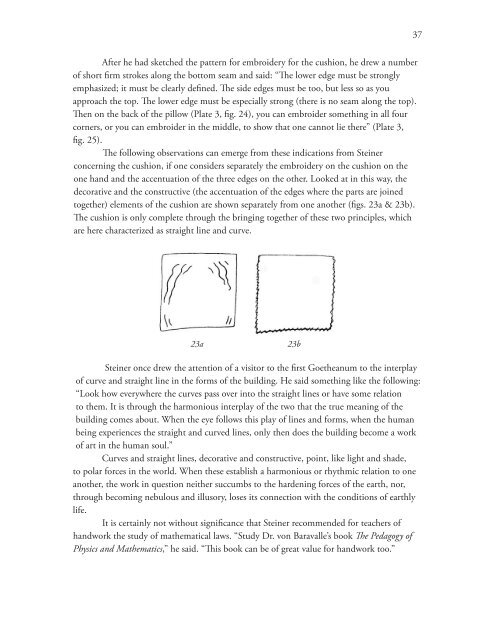Handwork and Handicrafts - Waldorf Research Institute
Handwork and Handicrafts - Waldorf Research Institute
Handwork and Handicrafts - Waldorf Research Institute
You also want an ePaper? Increase the reach of your titles
YUMPU automatically turns print PDFs into web optimized ePapers that Google loves.
37<br />
After he had sketched the pattern for embroidery for the cushion, he drew a number<br />
of short firm strokes along the bottom seam <strong>and</strong> said: “The lower edge must be strongly<br />
emphasized; it must be clearly defined. The side edges must be too, but less so as you<br />
approach the top. The lower edge must be especially strong (there is no seam along the top).<br />
Then on the back of the pillow (Plate 3, fig. 24), you can embroider something in all four<br />
corners, or you can embroider in the middle, to show that one cannot lie there” (Plate 3,<br />
fig. 25).<br />
The following observations can emerge from these indications from Steiner<br />
concerning the cushion, if one considers separately the embroidery on the cushion on the<br />
one h<strong>and</strong> <strong>and</strong> the accentuation of the three edges on the other. Looked at in this way, the<br />
decorative <strong>and</strong> the constructive (the accentuation of the edges where the parts are joined<br />
together) elements of the cushion are shown separately from one another (figs. 23a & 23b).<br />
The cushion is only complete through the bringing together of these two principles, which<br />
are here characterized as straight line <strong>and</strong> curve.<br />
23a<br />
23b<br />
Steiner once drew the attention of a visitor to the first Goetheanum to the interplay<br />
of curve <strong>and</strong> straight line in the forms of the building. He said something like the following:<br />
“Look how everywhere the curves pass over into the straight lines or have some relation<br />
to them. It is through the harmonious interplay of the two that the true meaning of the<br />
building comes about. When the eye follows this play of lines <strong>and</strong> forms, when the human<br />
being experiences the straight <strong>and</strong> curved lines, only then does the building become a work<br />
of art in the human soul.”<br />
Curves <strong>and</strong> straight lines, decorative <strong>and</strong> constructive, point, like light <strong>and</strong> shade,<br />
to polar forces in the world. When these establish a harmonious or rhythmic relation to one<br />
another, the work in question neither succumbs to the hardening forces of the earth, nor,<br />
through becoming nebulous <strong>and</strong> illusory, loses its connection with the conditions of earthly<br />
life.<br />
It is certainly not without significance that Steiner recommended for teachers of<br />
h<strong>and</strong>work the study of mathematical laws. “Study Dr. von Baravalle’s book The Pedagogy of<br />
Physics <strong>and</strong> Mathematics,” he said. “This book can be of great value for h<strong>and</strong>work too.”

















